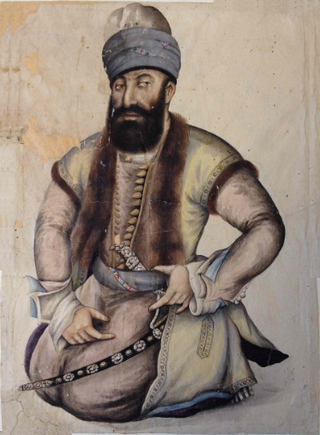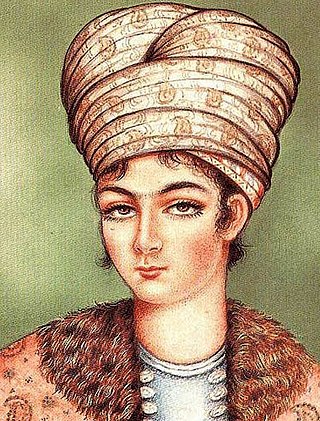Related Research Articles

Agha Mohammad Khan Qajar, also known by his regnal name of Agha Mohammad Shah, was the founder of the Qajar dynasty of Iran, ruling from 1789 to 1797 as Shah. Originally a chieftain of the Quwanlu branch of the Qajar tribe, Agha Mohammad Khan was enthroned as the king of Iran in 1789, but was not officially crowned until March 1796, having deposed Lotf Ali Khan of the Zand dynasty in 1794. Agha Mohammad Khan Qajar was famously the eunuch Monarch, being castrated as a toddler upon his capture by Adel Shah Afshar, and hence was childless. He was assassinated on 17 June 1797, and was succeeded by his nephew, Fath-Ali Shah Qajar.

Mohammad Karim Khan Zand was the founder of the Zand dynasty, ruling from 1751 to 1779. He ruled all of Iran (Persia) except for Khorasan. He also ruled over some of the Caucasian lands and occupied Basra for some years.

The Kingdom of Kartli-Kakheti was created in 1762 by the unification of the two eastern Georgian kingdoms of Kartli and Kakheti. From the early 16th century, according to the 1555 Peace of Amasya, these two kingdoms were under Iranian control. In 1744, Nader Shah granted the kingship of Kartli to Teimuraz II and that of Kakheti to his son Heraclius II, as a reward for their loyalty. When Nader Shah died in 1747, Teimuraz II and Heraclius II capitalized on the instability in Iran proper, and declared de facto independence. After Teimuraz II died in 1762, Heraclius succeeded him as ruler of Kartli, thus unifying the two kingdoms.

Claudius James Rich was a British Assyriologist, business agent, traveller and antiquarian scholar.
The Zand tribe is a Laki-speaking Kurdish tribe mainly populating the countryside of Khanaqin in Iraq and in the provinces of Kurdistan and Hamadan of Iran.
Abol-Fath Khan Zand was the third Shah of the Zand dynasty, ruling from March 6, 1779, until August 22, 1779.

Sadeq Khan Zand, also known as Mohammad Sadeq, was the fourth Shah of the Zand dynasty of Iran from August 22, 1779 until March 14, 1781.
Baban was a Kurdish principality existing from the 16th century to 1850, centered on Sulaymaniyah. The Baban Principality played an active role in the Ottoman-Safavid conflict and gave significant military support to the Ottomans. They were in constant rivalry with Ardalan, Bohtan and Soran and its territory would therefore oscillate. Before the removal of the last Baban leader in 1850, their rule had become limited to their capital Sulaymaniyah and few surrounding villages.

The Arg of Karim Khan or Karim Khan Citadel, is a citadel located in downtown Shiraz, Iran. It was built as part of a complex during the Zand dynasty. It is named after Karim Khan, and served as his living quarters. It is rectangular in shape and resembles a medieval fortress. In the past, the citadel was sometimes used as a prison. Today, it is a museum operated by Iran's Cultural Heritage Organization.
The Bajalan tribe, are an ethnic Kurdish Bajelani speaking tribe.
Fath-Ali Khan Afshar, was a chieftain from the Afshar tribe of Urmia, and one of the four contenders for supremacy in Iran between 1751–1763. He was ultimately defeated and captured in February 1763 by one of the contenders, the Zand ruler Karim Khan Zand. The latter had Fath-Ali Khan executed the following year, in July 1764.
Zaki Khan Zand was an Iranian military commander and contender for the throne. A member of the Zand dynasty of Iran, Zaki Khan, though he never became the ruler of Iran, managed to exert power over the country during the three months between the death of his half-brother Karim Khan, on March 2, 1779, and his own brutal death.

Lotf Ali Khan was the last Shah of the Zand dynasty. He ruled from 1789 to 1794.

Abu Torab, better known by his dynastic name of Ismail III (اسماعیل), was a Safavid prince, who reigned as a figurehead under the authority of Ali Mardan Khan Bakhtiari briefly from 1750 to 1751, and then under the Zand ruler Karim Khan Zand from 1751 till his death in 1773.

Mustafa Pasha Bajalan, was an Ottoman Kurdish general and administrator, He was the final head of the Bajalan family and his father was the last hereditary governor of the Pashlik of Zohab.
Ali Mardan Khan Bakhtiari was the Bakhtiari supreme chieftain (ilkhani) of the Chahar Lang branch, and major contender for supremacy in western Iran after the death of Nader Shah in 1747.

Shaykh Ali Khan Zand was a Zand nobleman, who was a close associate and prominent lieutenant of his cousin Karim Khan Zand. However, he later clashed with the latter, who had him blinded. He afterwards lived the rest of his life as an honored representative of the court, until a civil war occurred after Karim Khan's death in 1779, where Shaykh Ali Khan was killed by his cousin, Zaki Khan Zand.
Jamal al-Din Khan was the first khan of the Talysh Khanate under Iranian suzerainty, ruling from 1747 to 1786.
Mohammad Ajam, alternatively known as Muhammad al-Ajami or Ajam Muhammad, was an Iranian singer who lived in the late 18th century. He came to Baghdad during the Mamluk dynasty of Ottoman occupation. During the reign of Sulayman Abu Layla Pasha, he worked in politics until he reached the position of advisor and became the minister of Treasury in the time of Omar Pasha (1762–1776). He later became the leader of a rebel movement against Ottoman authority, which was defeated. He fled to Iran, then Egypt where he died. A melody type or Arabic maqam called ajam became common in Baghdad after him.
References
- ↑ Yar-Shater, Ehsan (1988). Encyclopaedia iranica, Volume 3, Issues 5-8. University of California: Routledge & Kegan Paul. p. 532.
- ↑ Rich, Claudius James (1836). Narrative of a residence in Koordistan, and on the site of ancient Nineveh. UK: Oxford University. p. 263.
- ↑ Rich, Claudius James (1839). Narrative of a journey to the site of Babylon in 1811: with narrative of a journey to Persepolis. UK: Duncan and Malcolm. p. 267.